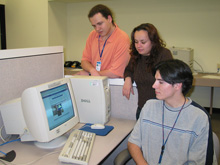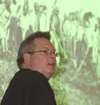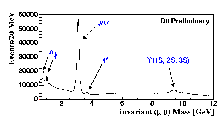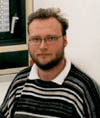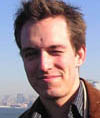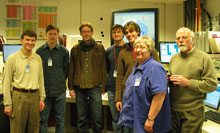 | Thursday, February 24, 2005 |
|
Thursday, February 24
Friday, February 25 |
|
Extended Forecast |
Secon Level 3 |
|
Thursday, February 24 Southwestern Chicken Tortilla Soup Philly Style Cheese Steak $4.75 Baked Fish w/ Roasted Leeks and Peppers $3.75 Tomato Basicl Chicken Parmesan $3.75 Classic Cuban Panini $4.75 Four Cheese Pizza $2.75 Marinated Grilled Chicken Caesar Salads $4.75 The Wilson Hall Cafe now accepts Visa, Master Card, Discover and American Express at Cash Register #1.
Wilson Hall Cafe Menu |
| Fermilab Today is online at: http://www.fnal.gov/today/ Send comments and suggestions to today@fnal.gov Fermilab Today archive Fermilab Today PDF Version Fermilab Result of the Week archive Fermilab Safety Tip of the Week archive Linear Collider News archive Fermilab Today classifieds Subscribe/Unsubscribe to |
|
E-Week Today: Grids for Engineers The Computing Division's Ruth Pordes will present today's E-week featured
The Director's talk to all engineers will be held at 3:00 p.m. today in One
West and will be immediately followed by an all engineers picture in the atrium.
A social recognition for all engineers will follow at Kuhn Barn.
|
|
February 21 - February 23 - During this 48 hour period, Operations established one store that combined with an existing store provided the experiments with approximately 37 hours and 35 minutes of luminosity - Linac had quad power supply problems - Main Injector had MECAR problems - Recycler stashed antiprotons
Read the Current Accelerator Update |
|
From the Daily Herald, February 23, 2005 Fermilab looking to trim staff By Tona Kunz Fermilab will ask some staff to voluntarily leave and will close the door on one experiment to mitigate budget shortfalls. But officials will keep another two dozen experiments and projects running as well as public tours and the hands-on science museum. "For about the last six years we've had what could be called flat funding, and at some point you have to make an adjustment to that," said spokesman Mike Perricone.
The high-energy physics laboratory on the eastern edge of Batavia plans within the next two weeks to start offering early retirement to its 2,100 full-time staff. At least 90 people, or 5 percent of the work force, need to take advantage of the offer or lab officials will consider layoffs.
|
|
Using Muons to See the Microcosm | ||||
| ||||
|
At DZero we are studying and searching for very rare particles, made in
proton-antiproton
collisions. However, these particles live for such a tiny fraction of a second
that we can never directly observe them, but have to reconstruct them from
their decay products.
In fact, of all the particles we know, relatively few survive long enough
to be measured directly. Among those we can detect are muons, which are a heavier
relative of the electron. Muons lose energy relatively slowly, and are generally
the only detectable particle to pass all the way through our experiment without
stopping. For this reason we have specialized muon detectors on the outer
edge of the experiment, which provide an unambiguous and low background
identification of muons.
| ||||
| ||||
|
Several types of particles decay to two muons, and by measuring both it is
possible to reconstruct the mass and properties of those particles (see
mass spectrum). At high mass, we see the Z boson and
searches are going on for previously unknown particles which are even heavier.
Muons can also be among the decay products of the heaviest known particle, the top quark. The Tevatron is currently the only place capable of producing the top quark, and the muon detectors are a good way of identifying and studying top candidates. Similarly, measurements of the second heaviest quark, the bottom, rely heavily on muon identification. Overall, the outstanding design and performance of the muon detectors at DZero have made it possible to produce world-class physics results. | ||||
| ||||
|
Result of the Week Archive | ||||
|
Yesterday's article "Fermilab Awards Safety Plaques and Posters," incorrectly
implied that Dave Carlson is associated with the Accelerator Division's Business Services.
Carlson is the head of the Business Services Section, which is not part of
the Accelerator Division. The article also stated a wrong number for the hours
of work performed by the Computing Division.
Director Mike Witherell presented the Computing Division with an award for
the best sustained safety performance for working nearly a million and
a half hours since their last lost time accident.
The article "E-Week Today: Architecture and Science," also in yesterday's issue, featured a photo of Curt Danner, Maurice Ball and Sten Hansen. The photo caption incorrectly stated that Curt Danner is an Electrical Engineer in the Particle Physics Division. Danner is a Technical Specialist in the PPD Electrical Engineering Department.
Fermilab Today regrets these errors.
|
|
International Folk Dancing International Folk Dancing will continue to be held once more, on February 24, at the Geneva American Legion Post at 7:30 p.m. There will no dancing next week, March 3, but then dancing will resume at Kuhn Barn beginning with a "Back to the Barn and Anniversary Party" on March 10. Info at 630-584-0825 or 630-840-8194 or folkdance@fnal.gov.
Tai Chi Classes
|
